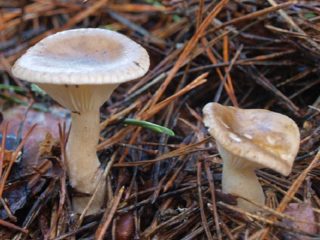Content
Mushroom picking is always associated with the risk of incorrectly determining the identity of the found specimen. White talker is a mushroom that attracts lovers with its appearance, but belongs to the 1st class of danger and is unsuitable for consumption.
Where do whitish talkers grow?
The whitish talker is often called whitish or bleached: these are synonymous designations.For a comfortable existence, these representatives of the mushroom kingdom choose mixed or deciduous forests. They appear on the edges, meadow areas, and can grow in cleared forests and parks. The variety grows in entire colonies, forming circles, which are also called “witch circles”.
What whitish talkers look like
The name “whitish” or “bleached” mushrooms is due to the fact that their legs and plates are white.
- The hat of young talkers takes on a convex shape with the edges bent inward. In older specimens, the surface may be flat, depressed in the center. The diameter of the cap is from 2 to 6 cm. In adult mushrooms, fuzzy grayish spots may appear on it. The plates of representatives of the species are frequent and white.
- The leg grows up to 4 cm and can be straight or slightly curved. In adult fruiting bodies, it becomes hollow inside.
After rains and morning dew, the caps are covered with fibrous mucus, but in dry, hot weather they dry out and become silky and pleasant to the touch.
The smell from the fruiting body is characterized as mealy or putrid. When the cap is broken, the flesh does not change color and remains elastic and fibrous in structure.
Is it possible to eat whitish talkers?
White or whitish talkers are poisonous mushrooms that can cause severe poisoning. There are known cases of death after their use. The fruiting body of representatives of this species contains a toxic substance - muscarine - an alkaloid that provokes heart rhythm disturbances.
How to distinguish whitish talkers
Other representatives of the Govorushkov genus have similar features to the whitish talker.
Differences | Wood-loving | Fragrant | Belesaya |
Where does it grow | On rotting stumps, on trees, 2 - 3 pcs. | On the edges, in ravines. | In mixed forests, edges, grass substrates. |
External description, smell | Wide plates, characteristic mushroom smell. | In adult mushrooms, the cap becomes grayish in color. | Powdery smell, frequent plates. |
Is it possible to eat | Refers to conditionally edible. | Refers to conditionally edible. | Poisonous. |
Wood-loving talker:
Fragrant:
One of the characteristic features of the whitish talker is that the species does not grow in 1 - 2 copies, but always forms entire groups of 10 - 15 pieces.
Symptoms of poisoning
When it enters the body, it acts primarily on the organs of the gastrointestinal tract. The first signs of poisoning appear after 20 minutes:
- nausea followed by repeated vomiting;
- increased salivation;
- sweating;
- chills, fever;
- abdominal pain, diarrhea;
- rapid heartbeat;
- blood pressure disorders.
Due to these symptoms, the respiratory process is complicated. A person may choke; such attacks are complicated by repeated vomiting.
First aid for poisoning
According to statistics, mushroom poisoning occurs in 4% of the total number of poisonings. The severity depends on the individual characteristics of the organism, as well as on how quickly relief measures were taken.
The first action after assessing the situation and identifying whitish talker as a poisonous mushroom is to call an ambulance. Before the arrival of specialists, it is recommended to take measures on your own:
- Taking large amounts of fluid. Drinking plenty of fluids helps remove toxins from the body faster and acts as a stomach cleanser.It is recommended to use pure mineral water without gases, self-prepared saline solutions, as well as Regidron or potassium permanganate (weak).
- Taking special medications that promote the absorption and removal of poisons from the stomach. They recommend Enterosgel, activated carbon, Smecta, Polysorb.
- If you have a high temperature, take antipyretic drugs: Paracetamol or Ibuprofen.
- For breathing problems, Atropine is used.
The main rule for helping with talker poisoning is to prevent dehydration. Drinking plenty of fluids and using specially prepared solutions help minimize the risk of possible complications.
Conclusion
White talker is a poisonous variety that should not be eaten even after prolonged processing. When picking mushrooms, you must carefully examine the surface of the fruiting body. This will help to accurately distinguish poisonous specimens from conditionally edible ones.













